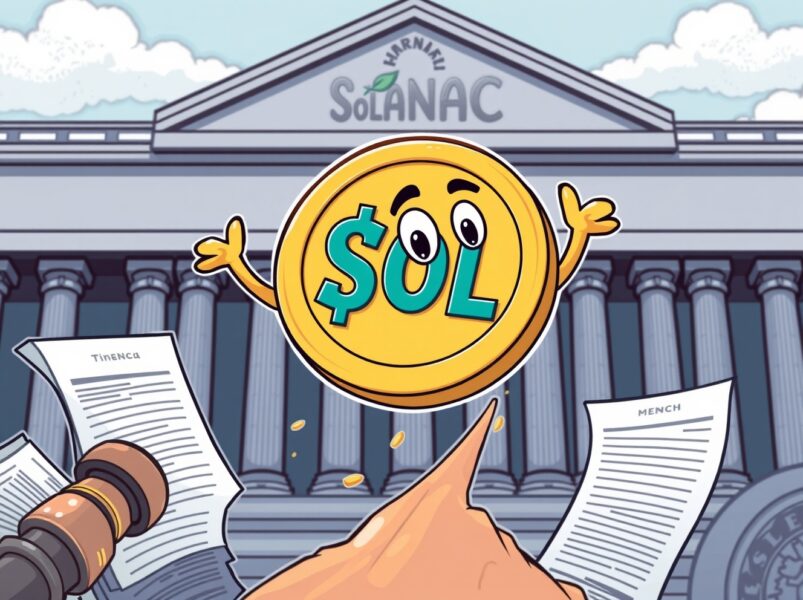Unlocking Potential: Canary Capital Files 7th Spot Solana ETF Application
0
0

BitcoinWorld
Unlocking Potential: Canary Capital Files 7th Spot Solana ETF Application
The cryptocurrency investment landscape is abuzz with significant news: Canary Capital has filed its seventh amendment for a Spot Solana ETF application with the U.S. Securities and Exchange Commission (SEC) on October 28. This persistent pursuit highlights the growing institutional interest in Solana (SOL) and its potential integration into traditional finance. The proposed management fee for this groundbreaking fund is set at a competitive 0.5%.
This repeated effort by Canary Capital signals a strong belief in Solana’s future and its suitability for a regulated investment product. Investors are keenly watching how the SEC will respond to this latest submission, as a spot ETF could dramatically change how mainstream finance interacts with the SOL ecosystem.
What Exactly is a Spot Solana ETF and Why is it Significant?
A spot Exchange Traded Fund (ETF) is an investment vehicle that holds the underlying asset directly. In this case, a Spot Solana ETF would directly hold Solana (SOL) tokens, allowing investors to gain exposure to SOL’s price movements without actually owning or managing the cryptocurrency themselves.
This differs significantly from a futures ETF, which tracks the price of futures contracts for an asset. Direct ownership offers a more accurate reflection of the asset’s real-time market value.
The significance of a Spot Solana ETF is multi-faceted:
- Accessibility: It opens the door for traditional investors who might be hesitant to navigate crypto exchanges.
- Regulatory Clarity: Approval would grant Solana a new level of legitimacy within regulated financial markets.
- Institutional Adoption: It could attract substantial capital from institutional investors, pension funds, and wealth managers.
Ultimately, a spot ETF offers a familiar, regulated wrapper for a volatile digital asset, making it more palatable for a broader range of investors.

Navigating the Regulatory Maze: Why So Many Amendments for a Spot Solana ETF?
The journey for any cryptocurrency ETF, especially a spot product, is often a long and challenging one. The SEC has historically approached crypto ETFs with extreme caution, primarily citing concerns around market manipulation, investor protection, and the nascent nature of digital asset markets.
Canary Capital’s filing of a seventh amendment demonstrates their commitment to addressing these regulatory hurdles. Each amendment typically involves refining the application based on feedback from the SEC, providing more detailed information on market surveillance, custody arrangements, and risk management strategies.
Consider the precedent set by Bitcoin and Ethereum ETFs. Both faced numerous delays and rejections before eventually gaining approval, first for futures products, and then, more recently, for spot versions. The SEC’s stringent review process aims to ensure that any new financial product offers adequate safeguards for investors and operates within a robust regulatory framework.
Therefore, the multiple amendments for a Spot Solana ETF are not unusual. They reflect the iterative dialogue between applicants and regulators, as they work towards a mutually acceptable structure for these innovative investment products.
What Could a Spot Solana ETF Mean for the Solana Market?
The potential approval of a Spot Solana ETF could have profound implications for Solana (SOL) and the broader cryptocurrency market. Historically, the approval of similar products for other cryptocurrencies has led to increased liquidity and heightened investor interest.
Should the SEC give the green light, we might see:
- Increased Demand: New avenues for capital inflow from institutional and retail investors.
- Enhanced Price Discovery: A more efficient and transparent pricing mechanism for SOL.
- Market Validation: A significant boost to Solana’s credibility as a major blockchain platform.
Investors should closely monitor SEC announcements and market reactions. While an approval could be a bullish catalyst, the crypto market remains dynamic and subject to various influences. Staying informed about regulatory developments is a key actionable insight for anyone interested in the future of Solana and digital asset investments.
A Glimpse into Solana’s Future with a Potential Spot Solana ETF
Canary Capital’s persistent efforts to launch a Spot Solana ETF underscore a pivotal moment in the evolution of cryptocurrency investments. The filing of the seventh amendment signifies a continuous dialogue with regulators, aiming to meet the rigorous standards required for mainstream financial products. While the path to approval is often arduous, the potential benefits—from enhanced accessibility for traditional investors to increased institutional adoption—are immense. This development could solidify Solana’s position as a mature and recognized asset class within the global financial landscape, marking a significant step towards broader cryptocurrency integration.
Frequently Asked Questions (FAQs)
What is the primary difference between a spot ETF and a futures ETF?
A spot ETF directly holds the underlying asset, like actual Solana tokens, meaning its price movements closely track the asset’s real-time market value. A futures ETF, however, invests in futures contracts that speculate on the future price of an asset, which can sometimes diverge from the immediate spot price.
Why is the SEC so cautious about approving a Spot Solana ETF?
The SEC’s caution stems from concerns about market manipulation, the protection of investors, and the overall maturity and regulatory oversight of the underlying cryptocurrency markets. They require extensive safeguards and transparency measures before approving new, complex financial products.
What is Solana (SOL)?
Solana (SOL) is a high-performance blockchain platform designed for decentralized applications (dApps) and crypto projects. It is known for its high transaction throughput and low fees, making it a competitor to Ethereum in the smart contract space.
What are the potential benefits for investors if a Spot Solana ETF is approved?
If approved, a Spot Solana ETF would offer investors easier access to Solana’s price movements through traditional brokerage accounts, without the complexities of direct crypto ownership. It would also provide a regulated investment vehicle, potentially attracting more institutional capital and offering greater transparency.
How does Canary Capital’s 0.5% management fee compare to other crypto ETFs?
A 0.5% management fee is generally considered competitive within the ETF space, especially for a novel asset class like cryptocurrency. It is often lower than fees for actively managed funds and can be attractive to investors seeking cost-effective exposure to Solana.
If you found this article insightful, consider sharing it with your network! Your support helps us continue to provide valuable insights into the evolving world of cryptocurrency. Join the conversation on social media and let us know your thoughts on the future of the Spot Solana ETF.
To learn more about the latest crypto market trends, explore our article on key developments shaping Solana institutional adoption.
This post Unlocking Potential: Canary Capital Files 7th Spot Solana ETF Application first appeared on BitcoinWorld.
0
0
 Manage all your crypto, NFT and DeFi from one place
Manage all your crypto, NFT and DeFi from one placeSecurely connect the portfolio you’re using to start.





